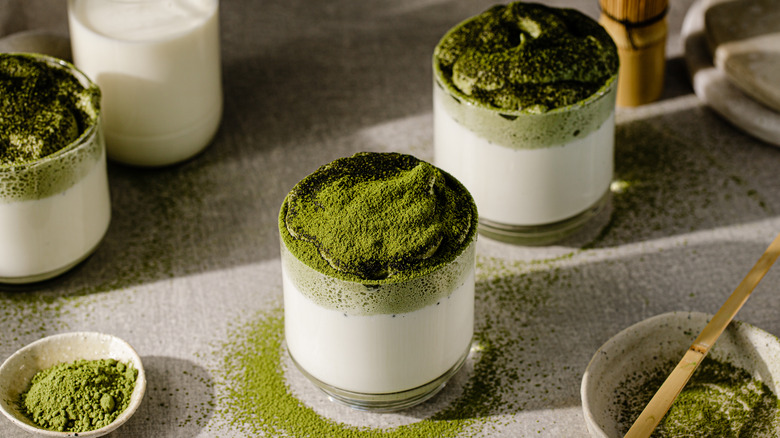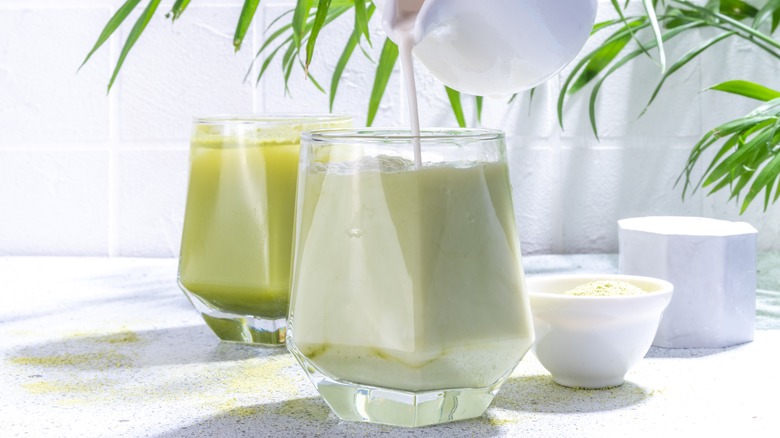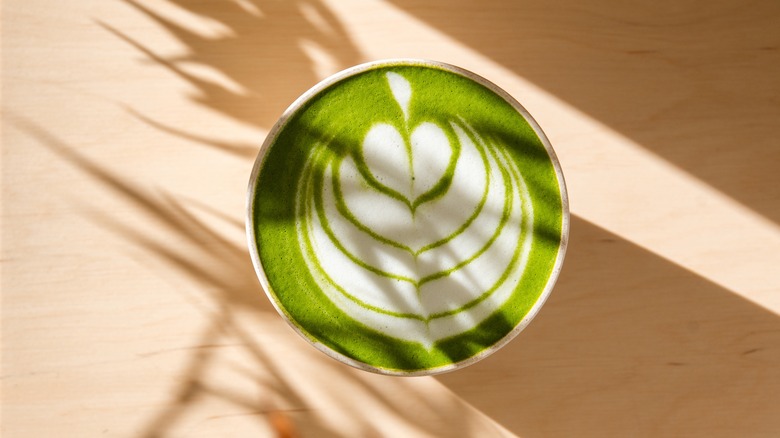What Type Of Milk Makes For The Absolute Best Matcha Latte?
From its ancient Buddhist beginnings to its prospective global demand to secure $5.5 billion in revenue by 2027, the renowned unraveling of earthy sentiments caught inside the fine powder of matcha is a glory to behold. The vibrant, pale green hue is iconic, and its deep, robust aroma teems with antioxidants. Amongst modern applications with matcha is one that reigns supreme: the matcha latte. However, with so many milk varieties available at various temperatures, are you sure you're choosing the best option when you order?
You can use a variety of dairy or non-dairy milk in a matcha latte; it is ultimately up to personal taste. However, one characteristic you may wish to consider is temperature. Iced matcha lattes embody a refreshing, more umami presence than hot versions, which tend to have a sweeter, nutty aroma. Both latte temperatures pride themselves on being creamy and smooth.
Ideally, for hot matcha lattes, it's best to identify milk that will not overpower the subtle flavors of matcha but can also be efficiently heated to produce an excellent foam without curdling. For an iced matcha latte, you are free to use milk that may usually curdle or does not foam beautifully, as there is no heating involved. We'll unpack the realm of matcha and milk pairings in the hope you'll find the right one for your latte needs. Note: This exclusively delves into hot lattes, acknowledging that specific kinds of milk might perform better in cold variations.
Dairy matcha latte options
From whole milk to semi-skim, low-fat to fat-free, dairy milk typically has a fresh and faintly sweet taste. For coffee-filled lattes, whole milk is usually the preferred choice, as its higher fat content allows the milk to achieve that smooth, thick foam. However, when paired with matcha, its bright richness can overshadow the mellow flavors of the tea.
On the other end of the spectrum are fat-free or skim milk, which have the lowest calories and fat content. These have a thin consistency and will struggle to achieve the creamy thickness desired in a hot latte, but may work well in an iced version where foam is not required. In between whole and fat-free falls 2% or reduced-fat milk, which is considered an agreeable pairing for matcha lattes, as it retains a foamy, creamy texture but tones down the heavy, rich flavor of whole milk.
Research published in the Journal of Photochemistry and Photobiology indicates that a protein in dairy, casein, might affect the absorption of antioxidants (called catechins) in the body. Matcha is particularly high in catechins. Consequently, drinking matcha with dairy may negate its potential nutritional benefits. However, as identified by current studies, more research is needed in this sphere. In this regard, choosing a plant-based milk lacking this protein might be more advantageous.
Oat, almond, and coconut milks
Coconut milk has a wonderful, creamy taste reflective of its thicker form, yet unfortunately, the thin texture of this non-dairy milk can be challenging to foam and more prone to curdling at high heat. Alongside this, coconut milk has a very prominent flavor profile and will create a matcha latte that explores two different aromas instead of complementing each other. Luckily, an iced matcha latte is exactly where coconut milk shines. There is no risk of the milk curdling, and the more robust matcha flavor matches its intense taste.
On the other hand, oat milk is exceptionally creamy, deliciously oaty, and naturally sweet, making it a fantastic pairing with matcha if you seek a less bitter interpretation of this beverage. It foams wonderfully and adds delectable richness without clouding the flavor of matcha beyond recognition. Almond milk has a similar texture profile as oats, but its nutty disposition brings a warmth to the matcha that beautifully complements the earth tones playing throughout both ingredients.
There's no time to waste good matcha on lattes that aren't capturing the very best of this tea. Opt for a creamy, delicious latte by choosing a milk that perfectly highlights this gorgeous tea.


